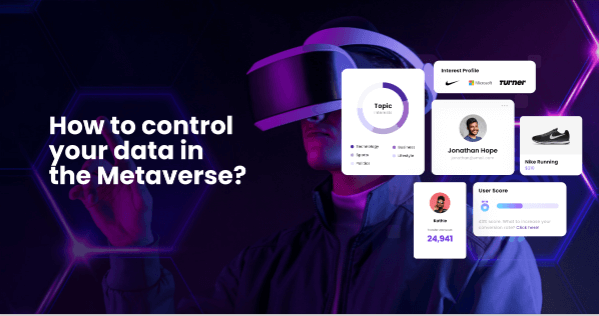Before you launch your first metaverse project, there is a critical question you need to answer. How will you control metaverse data?
3 Reasons Why To Control Your Metaverse Data
Controlling your data in a metaverse environment is vital for a few reasons.
It won’t be easy to get feedback to improve customer service and future metaverse projects without control over your data. By controlling your data in this new area, you can stay competitive with future expectations.
- Data and Security Compliance.
Your customers expect you to protect their data. At a minimum, you should fulfill local regulatory requirements like California Consumer Privacy Act (CCPA) or GDPR. Even if those laws do not directly apply to your company, it may be worth meeting those requirements to protect your requirements.
Finding success in marketing requires a commitment to testing and innovation. By tracking what works and what doesn’t in your metaverse, your continuous improvement efforts can continue.
Now let’s look at some of the data you might want to control in the metaverse.
Four Types of Metaverse Data Should You Protect
The specific kinds of data you put into the metaverse and get out of it will vary depending on your approach. A company that creates or uses a persistent virtual world such as Roblox will manage a significant volume of data. In contrast, a company offering a virtual metaverse event once or twice per year will have far fewer customer data profiles to manage.
Your metaverse experience will require a variety of types of content to engage customers. For example, you might create images and videos. For live virtual events in the metaverse, you may create a virtual event script. You might create metaverse content in-house, work with consultants or agencies. Before putting your content into a metaverse environment, get clarity on copyright and intellectual property first. For example, do you retain rights to the content, or are there any limitations to keep in mind?
- Customer Data And User Data
You may welcome several kinds of users to your metaverse environments: customers, potential customers, and partners. Given the effort required to track users effectively, it is probably wise to focus on customers. The best approach is to use a platform like the Arena Personas. It makes it easy to track customer activity across multiple platforms, including website usage, interactions with sales, social media, and more.
Protecting analytics data related to your metaverse events and environments is essential. For example, you might offer a series of metaverse events aimed at different audiences like small business owners vs corporate executives. At a minimum, track time usage metrics like how long users stay in the metaverse environment. Further, track how many of your users interact with your metaverse offerings. Low usage rates may suggest that your approach to the metaverse may not be appealing.
Qualitative data is meant to capture any other kinds of feedback you may receive about your metaverse environment. For example, users may use Live Chat on your website to ask technical support questions. Keeping track of these questions and feedback is essential. If users struggle to access metaverse content, it is wise to respond to that feedback so you can keep improving. Further, you may also get comments on social media and email about your offering. These comments may give some valuable insights worth reviewing with your team.
How To Control Metaverse Data Step By Step
Use the process to control your metaverse data so that you achieve your business goals.
1. Create A Customer Data Inventory
While you may have multiple types of participants – customers, prospective customers, and influencers – in your events, it makes sense to focus mainly on customer data. The answer is simple. Ultimately, your business goals are likely mainly focused on customer loyalty, customer service, and revenue. Therefore, it makes sense to focus on controlling and managing customer data.
To build your customer data inventory, start with the following examples.
- Customer Orders and Invoices.
Customer purchase activity gives you rich insights about which products are most popular with which customers. You can also use this data to identify your “VIP” customers by purchase activity.
- Customer Relationship Management.
Whether you use Salesforce or another CRM, these tools give valuable insights into customer interaction. For instance, a B2B company might want to identify and invite multiple stakeholders to a metaverse event (e.g., executives, technical experts, procurement, and more) to maximize engagement.
Track which customers are interacting with you on social media. If you are active on multiple platforms, consider focusing on the top 2 platforms with the most followers.
The questions customers ask during live chat sessions can offer valuable insight. This data should be collected and protected.
Website analytics and usage data can provide insights on which content and products customers are most interested in. Protecting this data is worthwhile because it helps you optimize your marketing efforts.
2. Classify Your Customer Data
It takes time and energy to protect customer data. Therefore, it makes sense to focus your effort on the customer data that is most valuable. At a minimum, verify that you meet legal standards applicable to your company and jurisdiction. Some industries like healthcare and financial services may have additional data privacy and security requirements to meet.
After legal considerations are considered, look at the value of your customer data. You might emphasize live chat data logs from a marketing perspective because the questions help you create more effective marketing. When you first start customer data classification, it is best to keep your system simple with a few categories. You might use the following categories: Very Important, Important, and Minor Importance.
3. Identify Relevant Data For The Metaverse
In the previous steps, you created a company-wide inventory of your most significant customer data assets. As you develop your metaverse engagement, it is essential to identify which data will flow in and out of the metaverse. As a starting point, consider the following.
- Customer Engagement Data
- Questions
- Product Data. Specifically which products generate the most interest in terms of purchases and inquiries.
- Survey Data. Check if you have a recent customer satisfaction survey data set to reference.
In addition to the above data examples, it is vital to consider data flows. You will probably have data flow into the metaverse, and data flow out of the metaverse. An example of data outflow from the metaverse would be engagement data, such as which virtual experiences draw the most interest from your audience.
4. Test Your Data Tracking Capabilities With A Metaverse Sandbox
Testing your customer data with a metaverse sandbox is an excellent next step. A sandbox is a testing environment where you can see if your systems and processes are working effectively. You might ask a handful of employees to create dummy customer accounts and then interact with your company’s assets in the metaverse. Following the event, verify if your customer data platform was updated based on metaverse user activity (e.g., measure which users logged into the metaverse).
If data is not flowing out of the metaverse into your customer data platform, it is vital to quickly diagnose and fix that problem.
5. Update Your Privacy Policy and Procedures
Once you have a functioning link between your customer data platform and the metaverse, it is time to assess your approach to privacy. Your customers may ask how you will protect their data if they use your metaverse experience. Protect your company reputation by reviewing and updating your privacy policy to cover metaverse experiences.
In addition, discuss user privacy safeguards with any third parties you work with to create metaverse experiences. Once the privacy policy is updated, create training materials for your customer service support to address privacy questions if they come up.
6. Launch A Metaverse Experience
Your next step is to launch your first metaverse experience with live customers. When you first get started with new technology, plan for additional support. For example, you might want to add additional technical support staff to your live chat to help users. After your metaverse experience ends, send out a survey to users to gather their feedback.
7. Put Your New Metaverse Data To Use
Finally, evaluate the new data you have generated from your metaverse event. Start by checking the fundamentals like whether customer data profiles were updated to reflect participation in the metaverse. Second, look for additional insights like which aspects of the metaverse experience generated the most engagement. Based on these insights, you can make better decisions about your next marketing campaign.
The One Must-Have Technology For The Metaverse
You might think that virtual reality headsets are required to offer metaverse experiencers. Such hardware can help, but it is not required. The critical technology is a customer data platform! Without a CDP in place, evaluating whether your metaverse experiences are generating ROI will be very difficult. Click here to find out more about Arena Personas.



